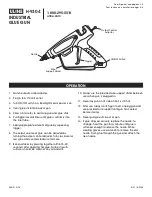
6
OPERATION
WARNING
The operator and other people in the
work area must wear eye protection
in accordance with ANSI Z87.1. Eye protection does
not fit all operators in the same way. Make sure the
eye protection chosen has side shields or provides
protection from flying debris both from the front
and sides. The employer is responsible for enforc
-
ing the use of eye protection by the operator and
other people in the work area. When required, wear
head protection in accordance with ANSI Z89.1.
Selecting Actuation Mode
The selectable trigger can be set to either Single Se-
quential Actuation mode or Contact Actuation mode.
Single
Sequential
Actuation
Contact
Actuation
1.Push in and hold the Actuation Selector.
2. Rotate the Selector to Single Sequential Actuation
(T) or Contact Actuation (TTT).
3. Release the Actuation Selector.
NOTE: Be sure the selector is snapped into position.
Understand the actuation process before use.
WARNING
To reduce the risk of injury to your-
self and others, test the tool before
beginning work each day according to the "Re
-
quired Daily Testing" section.
Do not use the tool unless you thoroughly under-
stand the actuation operation selected.
Disconnect the air supply from the tool and remove
fastener strips before leaving the work area, mov
-
ing the tool to another location, or handing the tool
to another person. Failure to do so could result in
serious injury.
Do not carry an air hose or a tool connected to an
air hose when climbing ladders, rigging or scaffold
-
ing. Do not attach an air hose or tool connected to
an air hose to your body when working at elevated
heights. Attach the hose to the structure to reduce
the risk of loss of balance and injury if the hose
shifts.
Do not use this tool for fastening electrical
cables. It is not designed for electric cable
installation and may damage the insulation of
electric cables thereby causing electric shock
or fire hazards.
Single Sequential Actuation Operation
1. Grip the handle firmly.
2. Position the nose of the tool on the work surface.
3. Push the tool against the work surface, compressing
the workpiece contact.
4. Pull the trigger to drive the fastener. The tool will recoil
away from the workpiece as the fastener is driven.
5. Remove your finger from the trigger and remove the
tool from the workpiece.
NOTE:
If the tool is not removed from the workpiece,
another fastener may be driven if the trigger is pulled
again.
Contact Actuation Operation
1. Grip the handle firmly.
2. Pull and hold the trigger.
3. Push the tool against the work surface, compressing
the workpiece contact to drive the fastener. The tool
will recoil away from the workpiece as the fastener
is driven.
NOTE:
Contact Actuation will also work by first com
-
pressing the workpiece contact, then pulling the trigger.
Reload Indicator
To indicate that the magazine is almost empty of fas
-
teners (about 4-5 left), the workpiece contact will not
compress, preventing operation under usual pressure.
Install more fasteners to continue working.
WARNING
NEVER wedge or hold back the
workpiece contact mechanism dur-
ing operation of the tool. Never attempt to clear a
jammed workpiece contact by grasping the dis
-
charge area of the tool. Doing so could result in
serious injury.
To avoid serious injury, do not attempt to prevent
the recoil by holding the tool too firmly against the
work. Keep face and body away from the tool. Dur
-
ing normal use, the tool will recoil immediately after
driving a fastener. This is a normal function of the
tool. Restriction to the recoil can result in a second
fastener being driven when the tool is in Contact
Actuation mode. Grip the handle firmly, let the tool
do the work, and do not place a second hand on
top of the tool or near exhaust.
Setting the Air Pressure and Depth of Drive
The amount of air pressure required will depend on the
size of the fastener and the workpiece material.
WARNING
Know what is behind your workpiece.
A fastener could travel through the
workpiece and out the other side, striking a by
-
stander and causing serious injury. Lower the air
pressure and/or depth of drive to prevent the fas-
tener from being pushed all the way through the
workpiece.
1. Lay the tool on its side and point the nose of the tool
away from yourself and others.
2. Disconnect the air supply from the tool and remove
fastener strip.
3. Set the depth of drive adjustment to the middle of its
range.
4. Reload fastener strip according to "Installing Fastener
Strips".
Set to
middle of
range







































